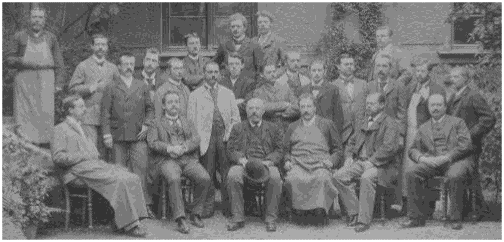 |
|
(This photograph is in the hallway across from 110 SCL)
|
Reading and Enrichment Assignments:
Problem Set 3
Chapter 4
Due: Monday, February 11, 2008
(This photograph is in
the hallway across from 110 SCL) In 1885, as an addendum to a paper on
acetylenic compounds, Baeyer proposed that cyclopentane
was the least
strained of the cycloalkanes.
While he accepted the idea that the carbon atoms in
cycloalkanes were tetrahedral, he treated the
cycloalkanes as though they were flat. He argued that
there is only one cyclohexane carboxylic acid, not two
(axial and equatorial) as was predicted by a chair
cyclohexane.

Reading and Enrichment
Assignments:
a. Work through How to Draw Cyclohexanes (PowerPoint)
b. Visit the Conformation Module in the Study Aids for cycloalkanes
c. Cultural Enrichment: The Evolution of Formulas and Structure in Organic Chemistry During the 19th Century (PowerPoint).
1. Compound A, a
1,4-disubstituted cyclohexane, contains 22.08% chlorine.
a) Determine the formula of A and the formula of the remaining substituent in A from the information in the lead sentence.
The difference in conformational energy for the two chair conformations of A is 1.68 kcal/mol.
b) Using the data in Table 4-3, page 145, determine the structure of A. Illustrate and explain.c) Estimate the conformational (lower limit) if the substituent had been attached differently (only one other way). Illustrate and explain.
d) What is the conformational energy difference for the stereoisomer of A, ---namely A'. Explain and illustrate. Show the chair comformations of A and A' with the appropriate equilibrium arrows to illustrate the major and minor conformations. Label each conformation with its energy.
2. Explain why cyclohexane is the least strained
cycloalkane based upon heats
of formation.
3. Check out the structure of limonene on
Wikipedia (don't worry about the issue of (+)-limonene or
(R)-enantiomer.) While the 2-D structure is truthful, the 3-D
version contains only "truthiness" (Wikipedia this!). What would be a
better presentation? Your 2-D version of your 3-D revision must be
able to be superimposed on the original 2-D version of limonene.
4. Hydrogenation of limonene produces cycloalkanes A and B, both C10H20. Compound A has the lower heat of formation.
a) Draw the conformational equilibrium for each of these compounds.b) Determine the energy difference for each equilibrium and designate the more stable conformation in each equilibrium.
c) Draw the most stable arrangement of the larger substituent when it is in the equatorial position.
5. cis-Decalin is ~2.6 kcal/mol less stable than trans-decalin (pg. 150) where a gauche butane interaction is worth 0.85 kcal/mol (one-half the value of CH3 in Table 4-3). [Hint: If you focus on axial substituents, you will probably get too large an answer. Think about the real source of the interactions.]
a) Explain and illustrate.b) What is cis-decalin capable of doing that the trans-decalin cannot do?
Consider the structure of cholic acid (pg. 154). It contains both a cis- and trans-decalin.
a) Redraw the structure on pg. 154 and label them.b) Why is the cis-decalin not capable of conformational inversion? (Make a stripped down version of the A-B-C ring system with your models to help yourself.)
c) Label all the methyls, hydroxyls and hydrogens attached to 6-membered rings in the picture as equatorial or axial.
d) Draw cholic acid as a 3D-structure (vide supra, pg. 154). Use the letter "R" for the carboxylic acid side chain.
2.